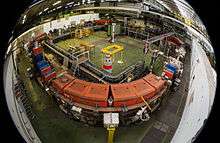Low Energy Ion Ring

The Low Energy Ion Ring (LEIR) is a particle accelerator at CERN used to accelerate lead ions from the LINAC 3 to the Proton Synchrotron (PS) to provide lead ions for collisions within the Large Hadron Collider (LHC).
History
LEIR was converted from a previous machine the Low Energy Antiproton Ring (LEAR); a facility to decelerate and store antiprotons[1] and to deliver them to experiments; the last LEAR antiproton run has taken place in 1996. LEIR was first proposed in 1993[2] but it wasn't until 2003 that work to transform the old experiment in to the new accelerator was started. The upgrade took just over two years being commissioned in October 2005[3][4] and tested for 4 months. In Autumn 2006 it was used to re-commission the PS to handle ions and then again a year later it was used to re-commission the SPS. However it wasn't until November 2010, five years later, that it successfully carried out its primary role to provide the lead ions to the LHC for its first ion collisions.[5]
Operation

LEIR takes long bunches of lead-208 ions from the LINAC 3, and splits them into 4 bunches. Each bunch contains 2.2×108 lead ions which are accelerated from 4.2 MeV per nucleon to 72 MeV per nucleon[6] before passing them through to the PS for storage.
The most important function of LEIR is not acceleration, but electron cooling to reduce the emittance of the ion beam in order maintain high luminosity of the final LHC beam. Each group of two bunches takes about 2.5 seconds to accelerate and cool, so with the LHC using 592 bunches of ions, it takes around 10 minutes for a complete fill of the LHC for operations.[7]
References
- ↑ http://public.web.cern.ch/public/en/research/Antimatter-en.html
- ↑ http://cdsweb.cern.ch/record/279362/files/
- ↑ http://cerncourier.com/cws/article/cern/29480
- ↑ http://accelconf.web.cern.ch/AccelConf/e06/PAPERS/WEOBPA02.PDF
- ↑ http://www.telegraph.co.uk/science/large-hadron-collider/8116226/Large-Hadron-Collider-creates-mini-Big-Bang-with-lead-ions.html
- ↑ A. Beuret; et al. (July 2004). The LHC Lead Injector Chain (PDF). Ninth European Particle Accelerator Conference (EPAC'04). Lucerne, Switzerland.
- ↑ Chanel, Michel (September 2003). "LEIR: The Low Energy Ion Ring at CERN" (PDF). CERN-AB-2003-086. Archived from the original (PDF) on 2013-03-29.